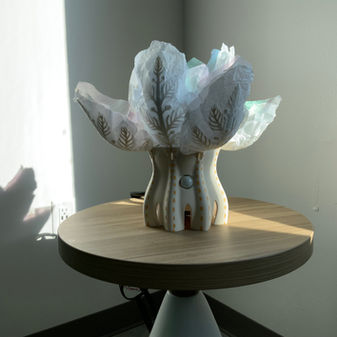top of page

How might we use biomimicry to apply sensory systems to products?
Scroll to see.

Fall 2021 | 10 weeks
SHI.
Setting the scene.
Background
My current class is about using Arduino to program a device that would sense and respond to human interaction.
What am I thinking?
Idea
I wanted my device to have emotion and personality.
The basic premise was that It would dance when no one was around, but when it sensed someone coming towards it, the device would get shy and hide.
What will it embody?
Inspiration
.png)
.png)
What happens when you mix these characteristics together?

+

+

+

=
?
How will it look?
Concept Development
I want the design to look like an aquatic living organism with floral characteristics.
Does it really work?
Proof of concept
I built several iterations of prototypes (not all shown) with different mechanisms to figure out how to make the petals open and close simultaneously.
.jpg)
The first batch of prototypes all relied on wires connected to each petal that required a down force, or pull, in order to make them close, and a push to open.

Using springs to force open and close.

Medium-fidelity representation of the final product.

Another idea was to use rotation around a central column to open and close the petals. There would be a servo motor inside to control the rotation. However, when 3D printed, it took numerous rotations just to close the petals, when it should only take half a turn, or 180 degrees.


3D printed small scale version using failed rotational mechanism.
.jpg)

Interestingly, we ended up going back to the beginning- creating a vertical down force. This was done by attaching 4 servo motors to the inner column, and connecting 2 petals to each servo motor arm.
I was then able to program a pulse movement by making them turn 0-100 degrees repeatedly, then 180 degrees (close) when the PIR sensor noticed movement.


With 8 petals, each one would crash during the test. So I added more slack for the wires that connected to everyother petal to make them delay.


When testing how the pulsing movement responded with LED strips added, the servos struggled to close. The wire used for soldering the strips to the breadboard were too resistant, so I used a lighter silicone based wire.

SHI.

bottom of page
_edited_edited.png)



















